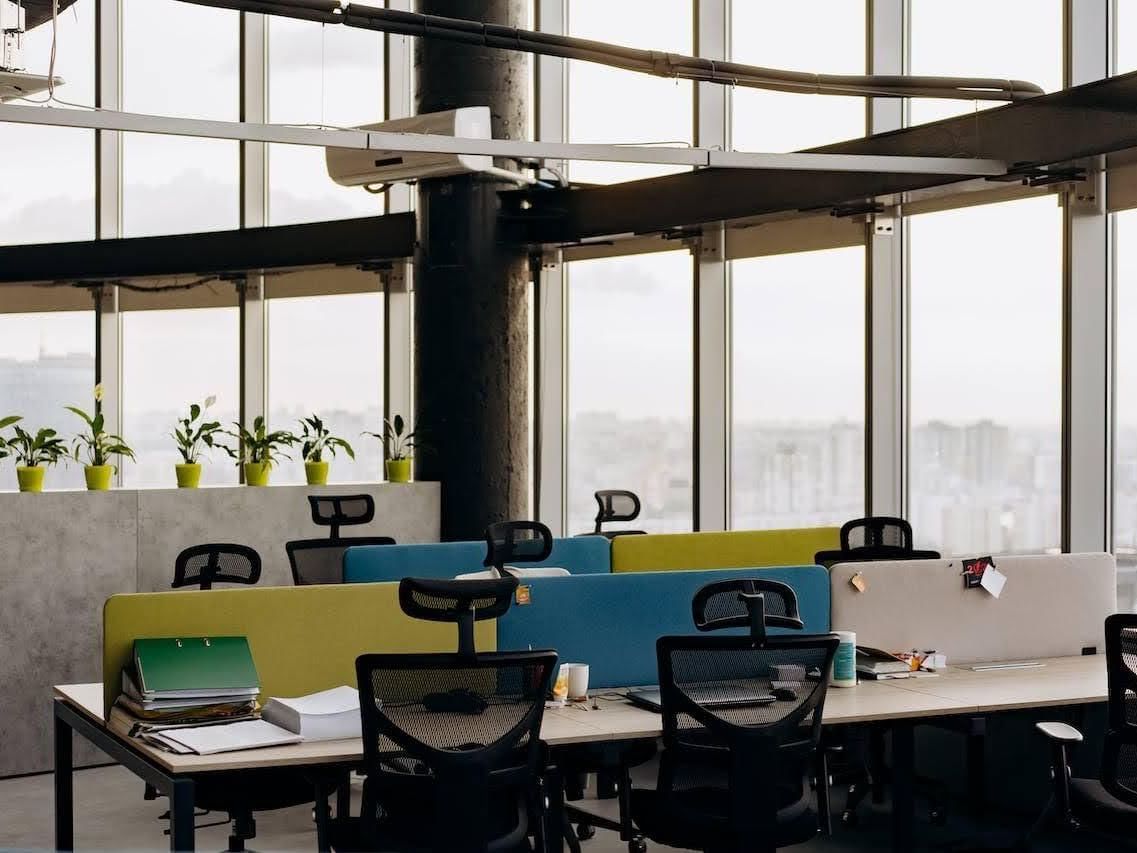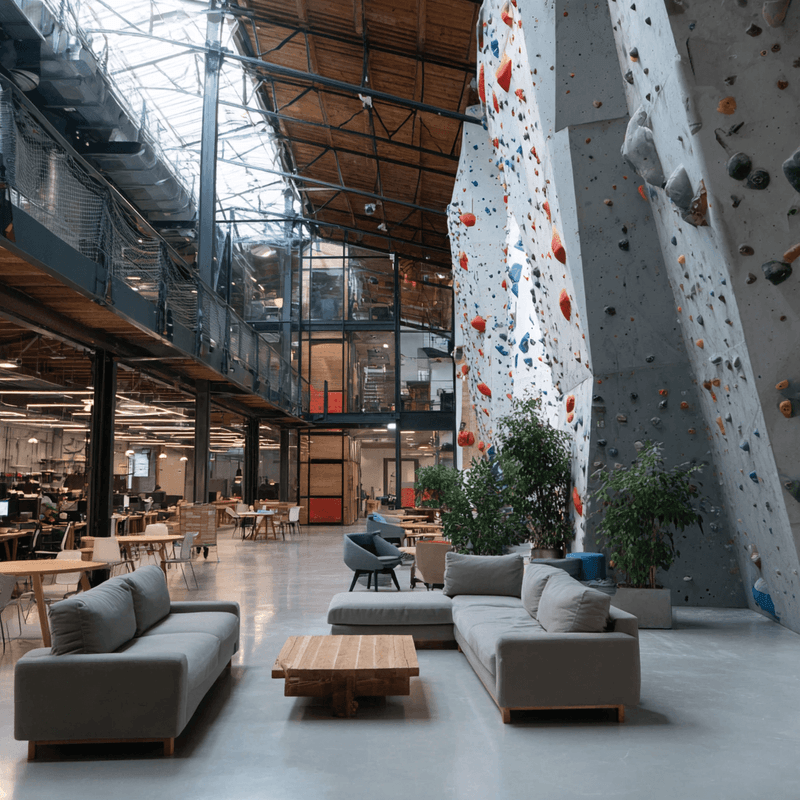
Our workplaces are constantly evolving, and the flex office is becoming an increasingly attractive solution for companies. But what is flex office? Flex offices are unassigned workstations. First appearing in the USA, this version 3.0 of the office allows business leaders to precisely control the filling of their workspaces, with an emphasis on flexibility.
Here's the definition of flexible offices, how they work and their benefits.
What are "flexible offices"?
Also known as "agile offices", "freeseating" or "desk sharing", the flex office arrived in France in the 1990s.
The idea is that employees are not assigned fixed desks. In other words, there are no assigned desks. All employees must empty their desks every evening.
This practice promotes flexibility in terms of location and working hours. Employees can come into the office, telecommute or work from a third location(coworking, café) close to home.
It also encourages collaboration and productivity. Flex Office employees can set up in the space that suits them best, and move around during the day according to their needs. This enables them, for example, to collaborate easily with people from other business sectors.
According to a study by JLL, 59% of companies are ready to adopt or intensify flex office, and 47% want to use it to rationalize their real estate.
Advantages and disadvantages of flexible offices
Flexible offices offer a range of advantages: greater flexibility, lower costs, improved collaboration... But they also have their drawbacks. As workspaces become more agile, their management becomes more complex. Let's take a look at the pros and cons of the flex office to help you decide if it's right for your business.
The benefits of the flex office
For 77% of those surveyed by Deskeo ina February 2021 study, the main benefit of flex office is reduced real estate costs.
And with good reason: a reduction in the number of workstations and office space is possible with flex office. When you consider that the average cost of a workstation in a company is €13,000 a year, it's easy to estimate the financial gain to be made by flex office.
As mentioned above, flex office is also synonymous with flexibility and cross-functionality. Employees can work wherever and with whomever they like, enabling them to be more productive and efficient. This can lead to greater job satisfaction and better understanding between employees.
With the help of the "clean desk policy", the flex office encourages teleworking, a mode of operation increasingly sought after by the French.
In short, flex offices enable employees to choose where they work, and to meet up with their colleagues at the office for informal socializing.
The disadvantages of flexible offices
Like all operating modes, the flex office also has a few drawbacks.
The first is the impersonal nature of the office. In the past, employees used to personalize their desks with family photos and a mug. Today, with the flex office, that's over! For some people, this can create a feeling of not belonging to the company.
Another disadvantage of flexible offices is that it's harder for managers to control their employees. They don't always know where they are or what they're doing... One solution to this problem is tohold regularteam meetings.
Finally, without a dedicated workspace, employees can find it hard to get organized. They can no longer store their belongings in places reserved for them. This can be disconcerting and intimidating for some. To overcome this inconvenience, we recommendusing a cloud storage solution and explaining to all your employees how to use it.
How can you successfully implement flex office in your company?
Are you planning to roll out a flexible office organization? Here are a few steps to follow to make it a success:
1. Define your objectives
Before setting up a flexible office, you need to define your objectives based on your constraints:
- How many people do you want to accommodate in your office at any one time?
- How many different workstations/spaces do you need?
- Do you prefer a large open space or lots of private offices?
To answer these questions, we advise you to carry out a diagnosis within your company to :
- define the actual workstation occupancy rate;
- analyze your employees' needs and habits.
If 20% of employees are considering switching to full remote, you know that 20% of your workstations will soon be unused. This will enable you to make well-considered decisions to maximize the success of this change.
2. Choosing flex office management software
Flex office management software is essential to the smooth running of a flexible office. It will enable your employees to reserve an office within the company and declare their teleworking days in 3 clicks.
This solution must be secure, scalable, reliable and ideally connected to Slack and Teams to facilitate communication and collaboration between your employees!
3. Define the legal and operational framework of the flex office
Third step: you'll need to work on the management side to set up this mode of operation. Your employees need to know what they can and cannot do in terms of working hours and location.
For example, they will need to know how to use the flex office management software and reserve a workstation easily. They'll also need to know where to look to find out where their colleagues work. Last but not least, clear rules need to be established for the use of common areas in terms of noise pollution and cleaning.
4. Supporting and training your teams
In the early stages, you'll need to be patient and test the waters. You'll need time to adapt to the flex office (generally less than 3 months).
During this time, it's important to communicate with your staff and make adjustments if necessary. Keep an eye on their productivity, satisfaction and any problems they may be experiencing, so you can deal with them quickly.
Flexible offices: what you need to know!
Flexible offices enable companies tooffer their employees maximum flexibility. It also enables them to adapt toindividual needs and personalities. If Mary wants to telework every Wednesday, she can do so with a flex office.
On the other hand, you need to ensure that you support your employees throughout the implementation of flex office. After all, this kind of flexibility can be a real headache for your employees, especially the older ones...
At workin.space, we're confident that you can introduce flex office to your organization. And if you're looking for smaller offices following the introduction of flex offices, we're here to help you in your quest.
-
Top 5 coworking spaces in Nantes

07/01/2026 Top 5 coworking spaces in Nantes
In Nantes, the office real estate market is experiencing a trompe-l'œil recovery: with 42,100 m² placed in the first half of 2025 (+14% vs. 2024), momentum seems to be picking up, but the market remains structurally fragile.New supply is scarce, average floor space is shrinking (386 m²), and the rise of telecommuting is causing office occupancy rates to fall below 50% on certain days. However, coworking, and more specifically the flexible office in Nantes, is emerging as a concrete response to new working practices for major accounts and their employees.
-
Sport coworking: when the workspace becomes a place of well-being and performance

22/12/2025 Sport coworking: when the workspace becomes a place of well-being and performance
After the democratization of telecommuting, the rise of the flex-office and the growing popularity of third places, a new trend is quietly but surely emerging: sports coworking. A trend as powerful as the French craze for running in France. At the crossroads of well-being, performance and transformed uses, these hybrid spaces are challenging the way we live and work.
-
Announcing the birth of new coworking spaces

01/12/2025 Announcing the birth of new coworking spaces
Looks like the family is growing! Everywhere in France in 2025, new coworking spaces and flexible workspaces are springing up, in Paris of course, but also in Rennes, Dijon, Clermont, Brest, and even in small towns that had never seen a shared office before.